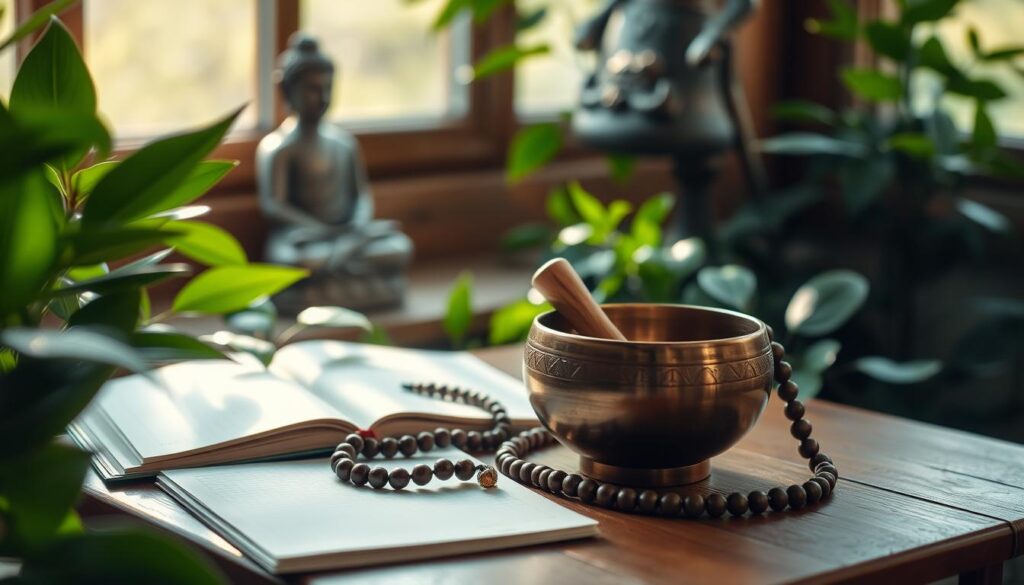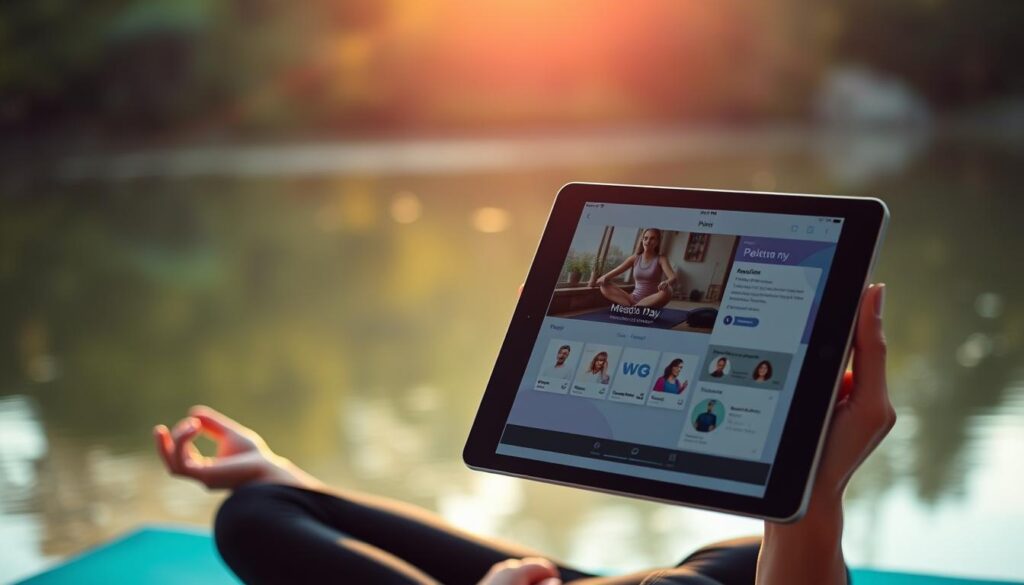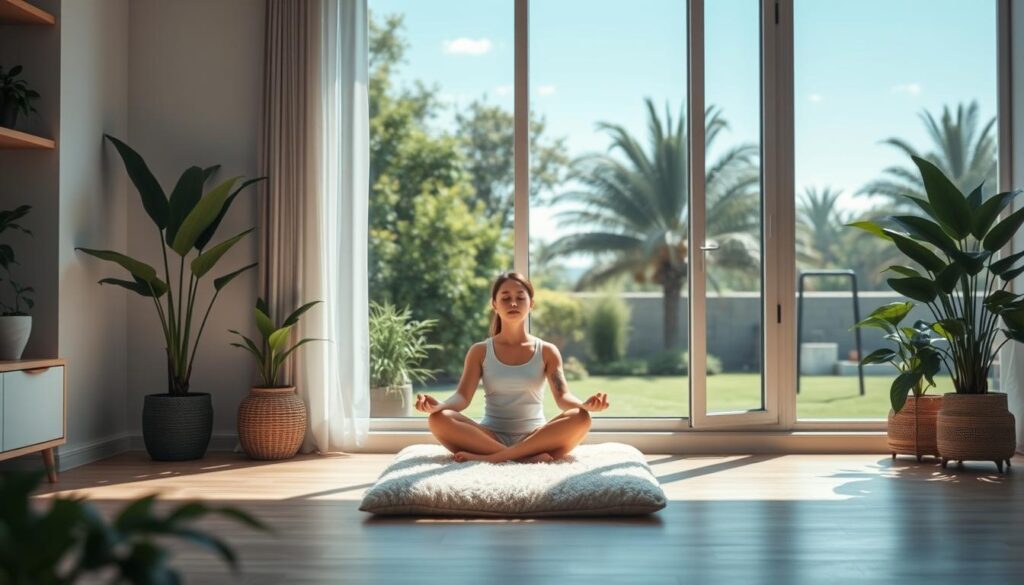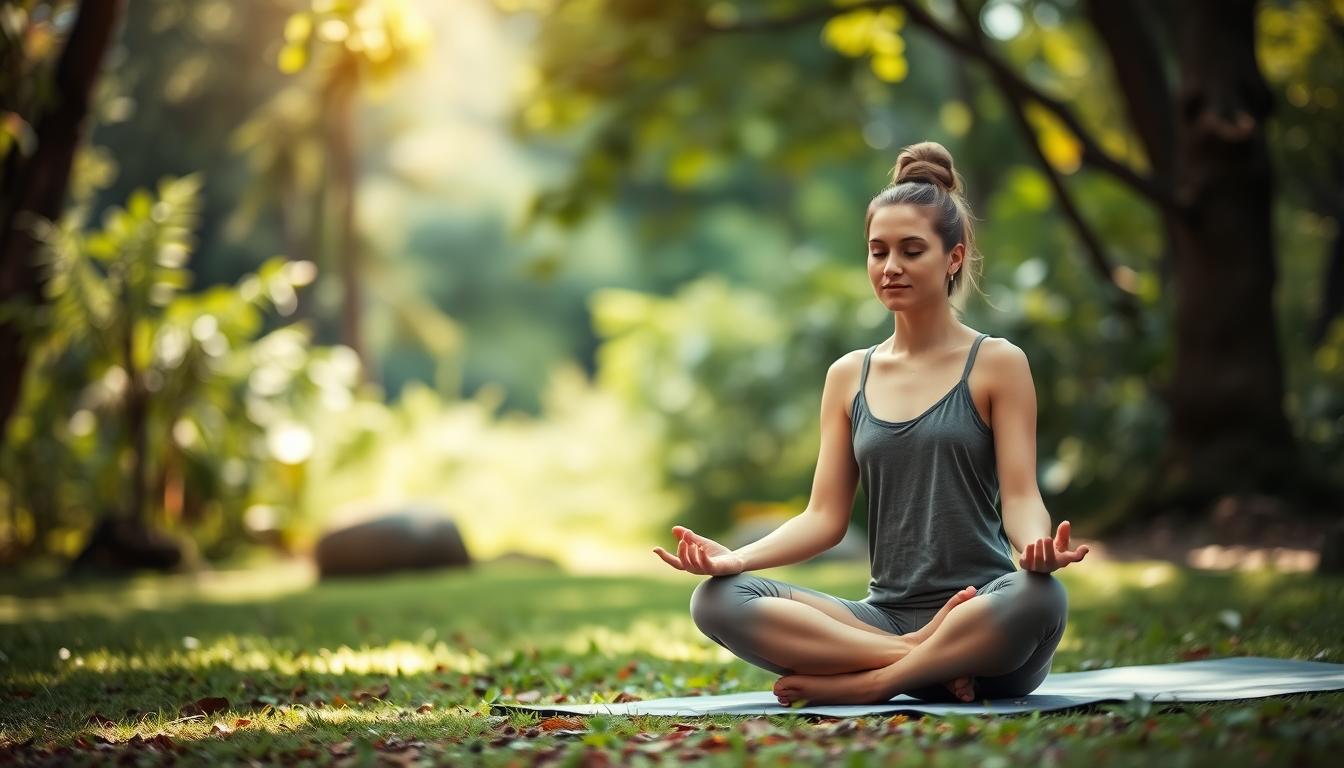I have been practicing meditation for some time now, and I’ve come to realize that it’s not about achieving some sort of mystic state or devoting hours to it every day. It’s quite the opposite – it’s about making a simple, yet powerful practice a part of our daily lives.
Many of us think that meditation is about completely emptying our mind of thoughts, but that’s a misconception. It’s actually about focusing our attention and being mindful of the present moment. We can start with just a few minutes a day, and as we continue, we can find our own rhythm and practice that works for us.
As we explore the world of meditation, we will discover its numerous benefits and how it can be easily integrated into our busy lives. We will also address the challenges that beginners often face and provide guidance on how to overcome them.
Key Takeaways
- Understanding that meditation is not about achieving a specific state, but rather a practice that can be adapted to our daily lives
- Recognizing that there is no “perfect number” of minutes for meditation – it’s about finding what works for you
- Learning how to integrate meditation into a busy schedule
- Understanding the benefits of meditation and how it can improve our lives
- Addressing common challenges faced by beginners and finding ways to overcome them
Understanding Meditation: More Than Just Sitting Still
Meditation is commonly perceived as a static practice, but in reality, it’s a dynamic process that can help us navigate our busy lives. As we dive into the world of meditation, we will explore what it truly is and debunk some common myths surrounding this practice.
What Meditation Really Is
Meditation is a practice that helps us cultivatemindfulness, allowing us to recognize our thoughts and emotions without getting caught up in them. It’s not about shutting down our brain or achieving a specific state; rather, it’s about being present in the moment. When we practice meditation, we are not trying to empty our minds of thoughts; instead, we are learning to observe our thoughts and maybe take a pause from the constant mental acrobatics. This practice can help us choose what we’d like to focus on, making it a powerful tool for managing our minds.
Debunking Common Meditation Myths
There are several misconceptions about meditation that might discourage people from practicing it. Let’s address a few of these myths.
Some people think that meditation requires completely emptying your mind of thoughts, but this isn’t the goal or even possible for most people. Others believe that meditation takes hours of your day, but even 5-10 minutes can be beneficial, especially for beginners.
Here is a summary of some common myths and facts about meditation in the table:
| Myth | Fact |
|---|---|
| Meditation requires a completely empty mind | It’s about observing thoughts, not eliminating them |
| Meditation takes a lot of time | Even 5-10 minutes a day can be beneficial |
| Meditation is only for certain people | It is beneficial for everyone, especially busy, stressed individuals |
| Meditation is complicated or requires special equipment | It can be very simple to start practicing |
By understanding what meditation truly is and dispelling common myths, we can approach this practice with a clearer mind and more realistic expectations. As we continue to explore the world of meditation, we will see how it can be a valuable tool for improving our lives.
The Science-Backed Benefits of Meditation
Recent studies have shed light on the profound effects of meditation on our overall well-being. Meditation isn’t just a moment of calm; it’s a practice that can reshape our minds and bodies in meaningful ways.
Physical Benefits for Your Body
Meditation has been shown to have a positive impact on physical health. Regular meditation practice can lower blood pressure, reduce chronic pain, and boost the immune system. By incorporating meditation into your daily routine, you’re not just calming your mind; you’re also taking care of your body.
| Physical Benefits | Description |
|---|---|
| Lower Blood Pressure | Regular meditation can help reduce hypertension. |
| Reduced Chronic Pain | Meditation can decrease the perception of pain. |
| Boosted Immune System | Meditation has been linked to enhanced immune function. |
Mental and Emotional Advantages
The mental and emotional benefits of meditation are just as significant. By practicing meditation, you can reduce stress and anxiety, improve your mood, and enhance your emotional well-being. Meditation helps you develop a greater sense of self-awareness, allowing you to navigate life’s challenges with more ease.
Meditation’s impact on the mind is profound. It can lead to a decrease in stress reactivity and an improvement in emotional regulation. This means you’re better equipped to handle life’s ups and downs without feeling overwhelmed.
Long-Term Effects on Brain Health
Research has shown that long-term meditation can lead to changes in the brain’s structure and function. Studies have found increased gray matter density in areas associated with learning, memory, and emotional regulation. Meditation can also slow age-related cognitive decline, potentially offering protective effects against conditions like dementia.
By incorporating regular meditation into your routine, you’re not just experiencing short-term benefits; you’re investing in your long-term brain health. This can lead to better decision-making, improved memory, and greater emotional balance.
How to Start Playing Meditation: A Beginner’s Approach
Embarking on a meditation journey can be both exciting and intimidating for beginners. As you start this new practice, it’s essential to understand that meditation is a skill that develops over time with patience and consistency.
Meditation isn’t about achieving a specific state; it’s about cultivating awareness of the present moment. To begin your meditation practice, consider the following key aspects.
Finding Your Ideal Meditation Time
Identifying the best time to meditate can significantly impact your ability to stick to the practice. Morning meditation can be beneficial as it sets a positive tone for the day. However, the most important thing is to choose a time that works consistently for you.
Experiment with different times of the day to find what suits you best. Whether it’s during your lunch break or right before bed, the key is to make meditation a regular part of your routine.
Creating a Comfortable Meditation Space
Your meditation space should be a haven where you can relax without distractions. It’s not necessary to create an elaborate setup; a quiet corner with a cushion or chair is sufficient. The goal is to have a consistent space that signals to your mind that it’s time to meditate.
Consider using elements like candles or soft lighting to create a calming atmosphere. The more you associate this space with relaxation, the easier it will be to meditate.
Setting Realistic Expectations
It’s crucial to understand that a wandering mind is a natural part of the meditation practice. It’s not about achieving a blank mind but about noticing when your mind wanders and gently bringing your focus back to your breath.
Beginners often expect immediate results or feel discouraged if their mind constantly wanders. However, the practice of noticing and refocusing is where the real benefit lies. Be patient with yourself and acknowledge that it’s a process.
| Meditation Aspect | Beginner Expectation | Reality |
|---|---|---|
| Mind State | Expecting a blank mind | A wandering mind is normal; the practice is in noticing and refocusing |
| Immediate Results | Expecting instant relaxation or bliss | Benefits accumulate gradually over time with consistent practice |
| Practice Consistency | Struggling to meditate daily | Starting small and being consistent is more important than the duration |
By understanding these aspects and setting realistic expectations, you can cultivate a fulfilling meditation practice that brings you peace and clarity.
The Perfect Meditation Duration for Beginners
As a beginner, one of the most common questions is: how long should I meditate? The answer depends on various factors, including your goals, schedule, and comfort level with the practice. Meditating every day helps build awareness, fosters resilience, and lowers stress.
Why 5-10 Minutes Is Ideal to Start
For beginners, starting with a short meditation practice of 5-10 minutes is ideal. This duration allows you to get accustomed to the practice without feeling overwhelmed. It’s long enough to experience some benefits, such as reduced stress and increased focus, but short enough to keep you engaged. As Barry Boyce, our founding editor, suggests, trying to meditate once a day for one month can help you notice the positive impact of this practice on your daily life.
| Duration | Benefits |
|---|---|
| 5-10 minutes | Reduces stress, increases focus |
| 10-20 minutes | Enhances mindfulness, improves emotional regulation |
| 20+ minutes | Deepens concentration, promotes a sense of calm |
Gradually Increasing Your Meditation Time
As you become more comfortable with meditation, you can gradually increase your meditation time. A good approach is to add one minute per week to your practice. This gradual increase helps you build a sustainable habit without feeling overwhelmed. It’s also essential to listen to your body and mind; if you’re feeling restless or uncomfortable, it might be a sign to adjust your meditation duration. Experimenting with different techniques, such as body scanning or counting breaths, can also make longer sessions more engaging and help you cultivate mindfulness.
“The key to a successful meditation practice is consistency, not duration. Start small, be consistent, and gradually increase your meditation time as you become more comfortable with the practice.”
By starting small and being consistent, you can develop a meditation practice that brings numerous benefits to your daily life.
Essential Meditation Techniques for Newcomers
As you start your meditation journey, it’s essential to explore various techniques to find what works best for you. With so many methods available, you can experiment to discover the most effective way to cultivate mindfulness and inner peace.
Breath-Focused Meditation
One of the most straightforward and effective meditation techniques is breath-focused meditation. This involves paying attention to your breath, observing its pattern, and gently bringing your mind back when it wanders. It’s an excellent way to anchor yourself in the present moment and reduce mind chatter.
To practice, find a comfortable seated position, close your eyes, and take slow, deep breaths. Focus on the sensation of the breath moving in and out of your body. When your mind drifts (and it probably will!), gently acknowledge the thought and return to your breath without judgment.
Body Scan Meditation
Guided meditation often incorporates body scan techniques, which involve paying attention to different parts of your body, starting from your toes and moving up to the top of your head. This practice helps in releasing physical tension and promoting relaxation.
As you lie down or sit comfortably, bring your attention to each body part, noticing any sensations, discomfort, or relaxation. The goal isn’t to change anything but to observe. This technique is particularly helpful for those who struggle with traditional sitting meditation due to physical discomfort.
Visualization and Guided Imagery
Guided meditations that use visualization and guided imagery can be particularly helpful for beginners. This technique involves imagining yourself in a peaceful, relaxing environment or scenario, such as lying on a beach or walking through a forest. It helps in creating a mental escape from stress and anxiety.
To practice, you can use guided meditation recordings or apps that lead you through visualization exercises. Imagine the sights, sounds, and sensations in detail, allowing yourself to fully immerse in the experience. This technique not only calms the mind but also nurtures your ability to focus and relax.
Building Your Meditation Habit
Building a meditation habit is easier than you think, and it starts with small, intentional actions. To make meditation a consistent part of your daily routine, you need to create an environment that supports your practice.
Creating Meditation Triggers and Reminders
One effective way to establish a meditation habit is by creating triggers and reminders. Put meditation reminders around you – place your meditation cushion in a visible spot or set reminders on your phone. Refreshing these reminders regularly can help keep your intention top of mind. For instance, using sticky notes with funny or varied messages can keep your autopilot brain engaged. You can also create “If this, then that” messages, like taking a deep breath when you enter your office or before answering a call, to shift into mindfulness mode.

Tracking Your Progress and Consistency
Tracking your meditation practice is crucial for maintaining consistency and noticing progress over time. Simple tracking methods, such as using a journal or a meditation app, can be very effective. It’s helpful to track metrics like frequency, duration, and the technique used, but avoid judging the “quality” of each session. Regular reflection on your practice, perhaps weekly or monthly, can help you notice subtle changes. Celebrating consistency milestones and tracking the effects of meditation on your daily life, such as mood and stress levels, can be powerful motivators to continue your meditation journey.
| Tracking Method | Benefits |
|---|---|
| Meditation Journal | Personal reflection, noticing patterns |
| Meditation Apps | Easy tracking, guided sessions |
| Sticky Notes | Reminders, simple tracking |
Overcoming Common Meditation Challenges
Meditation is simple, but that doesn’t mean it comes without its challenges – let’s explore some common hurdles and how to overcome them.
As we incorporate meditation into our daily lives, we may face a few obstacles that can make it difficult to maintain our practice. We will look into some of these challenges and discuss ways to overcome them.
Dealing with a Wandering Mind
One of the most common challenges when it comes to meditation is dealing with a wandering mind. When we meditate, our attention will inevitably leave the breath and wander to other things. When you notice that your mind has wandered, simply return your attention to the breath without judgment.
As the renowned meditation teacher, Jon Kabat-Zinn, once said, “As we meditate, we inject far-reaching and long-lasting benefits into our lives.”
“You can’t start over – you can only carry on from where you are, making new choices, making new decisions, making it up as you go along, making new changes – that’s what we are doing when we are meditating, that is what we are doing every day, all the day, whether we are aware of it or not.”
Managing Physical Discomfort
Another challenge we often face during meditation is managing physical discomfort. To minimize discomfort, create a comfortable meditation space, and use a chair or cushion that supports your back. If you experience discomfort during meditation, try to adjust your position or take a few deep breaths.
Here is a simple table to help you understand some common causes of physical discomfort during meditation and some possible solutions:
| Cause of Discomfort | Possible Solution |
|---|---|
| Sitting for too long | Take breaks, stretch, or change positions |
| Poor posture | Use a supportive chair or cushion |
| Tension in the body | Practice relaxation techniques, such as deep breathing |
Finding Time in a Busy Schedule
Finding time to meditate can be challenging, especially for those with busy schedules. To overcome this, identify “time leaks” in your day, such as time spent on social media or waiting in lines, and use these moments for brief meditation sessions.
As we try to fit meditation into our busy lives, let’s remember that even a minute of deliberate presence each day can make a difference. We can integrate meditation into our daily activities like commuting or waiting for meetings to begin.
By making meditation a priority and connecting it to our personal values and goals, we can make it a consistent part of our daily lives. Consistency is more important than duration, and even short periods of meditation can be beneficial.
Guided Meditation Resources for Beginners
When starting out with meditation, having access to guided meditations can make all the difference. As mentioned earlier, you can meditate on your own, but it is beneficial to have guided meditations at the ready.
For instance, you can browse the Peloton App for a wide array of offerings, including Aditi’s 3-Week Intro to Meditation course.

Apps and Digital Platforms
Several apps and digital platforms offer guided meditations specifically designed for beginners. Some popular options include:
Headspace and Calm are two leading meditation apps that offer guided meditations tailored to beginners. These apps provide a variety of mindfulness exercises and meditations that cater to different needs and preferences.
Free Online Meditation Resources
Besides paid apps, there are numerous free online resources available for those starting their meditation journey. You can find a variety of guided meditations on:
Websites like YouTube, for example, have numerous channels dedicated to meditation, such as Insight Timer and Meditation Studio. You can also explore podcasts and other online resources that offer free meditation content.
Integrating Mindfulness Into Your Daily Life
Bringing mindfulness into daily life can be simple and transformative. It is about incorporating awareness into our everyday activities, making each moment more meaningful and alive.
Mindful Moments Throughout Your Day
We can bring mindfulness into our daily routines by taking short pauses throughout the day. For example, taking three conscious breaths before checking email or starting your car can be a powerful way to bring mindfulness into your daily life. We can also practice mindfulness while performing tasks like cooking or gardening, focusing on the sensations and processes involved.
Another practice is walking meditation, where we pay attention to the sensation of each step, noticing the movement in our legs and the rest of our body. As we walk, we keep our hands in a comfortable position and focus on the lifting and falling of our feet.

Combining Meditation with Other Activities
Combining meditation with other activities, like exercise or creative pursuits, can enhance our experience, turning them into opportunities for mindfulness. For instance, we can bring meditative awareness to our workouts, focusing on our breathing and the physical sensations in our body. This approach can make our practice more accessible and enjoyable, making it a part of our daily life and enhancing our overall awareness.
By integrating mindfulness into various aspects of our daily lives, we can create a more balanced and mindful practice. This integration can help us stay connected to our meditation practice, even when we are not sitting in stillness.
Conclusion: Your Journey to Inner Calm Begins Now
The best way to get started with meditation is simply to begin – and that’s exactly what you’re poised to do. Throughout this article, we’ve explored the various facets of meditation, from its benefits to practical tips for incorporating it into your daily life. Remember, meditation is a skill developed through consistent practice, not a perfect state to achieve. The “best meditation number” is whatever amount you can do consistently, even if it’s just a few minutes daily. By focusing on your breath and coming back to the present moment, you can cultivate mindfulness in your daily activities.
Take a minute now to start meditation – simply focus on your breath and let go of expectations. Every moment offers a fresh opportunity to begin again.
FAQ
What is the best way to get started with meditation as a beginner?
To get started, find a quiet and comfortable spot to sit, close your eyes, and focus on your breath. You can use guided meditations to help you stay on track.
How long should I meditate for the first time?
For beginners, 5-10 minutes is an ideal duration. As you become more comfortable with the practice, you can gradually increase your meditation time.
What are some common challenges people face when trying to meditate, and how can they be overcome?
Common challenges include a wandering mind, physical discomfort, and finding time in a busy schedule. To overcome these, try to gently bring your focus back to your breath, adjust your position, and incorporate mindfulness into your daily activities.
Can meditation really help reduce stress and anxiety?
Yes, regular meditation practice has been shown to reduce stress and anxiety by promoting relaxation and increasing awareness of the present moment.
Are there different types of meditation techniques I can try?
Yes, some popular techniques include breath-focused meditation, body scan meditation, and visualization. You can experiment with different methods to find what works best for you.
How can I make meditation a consistent part of my daily routine?
To build a consistent meditation habit, try setting reminders, creating a dedicated meditation space, and tracking your progress.
Can I meditate if I’m not flexible or have physical limitations?
Absolutely, you can meditate in a chair or even while lying down. The key is to find a comfortable position that allows you to relax and focus.
Are there any recommended apps or resources for guided meditations?
Yes, there are many great resources available, including apps and online platforms that offer guided meditations for beginners.
